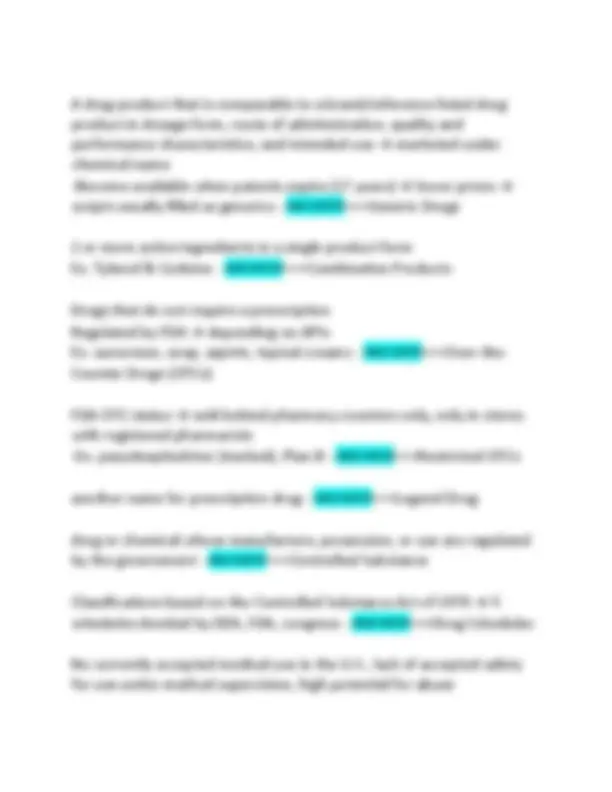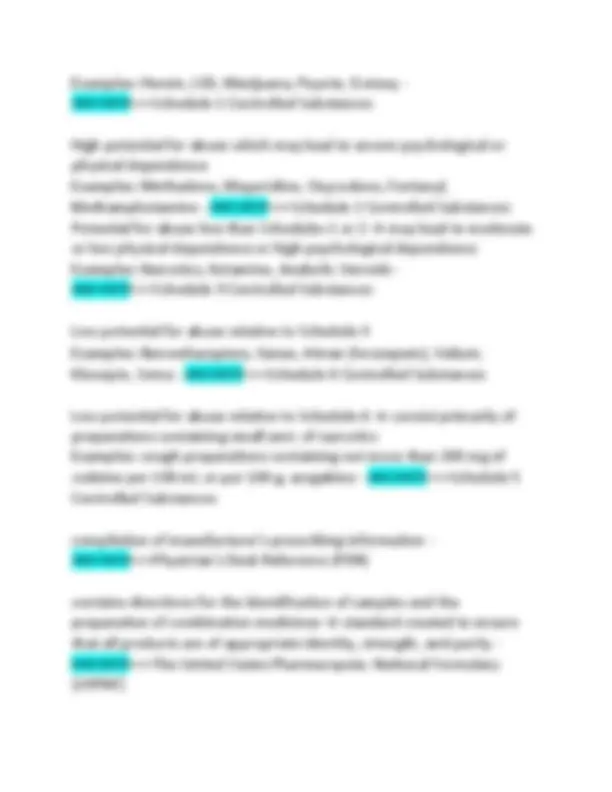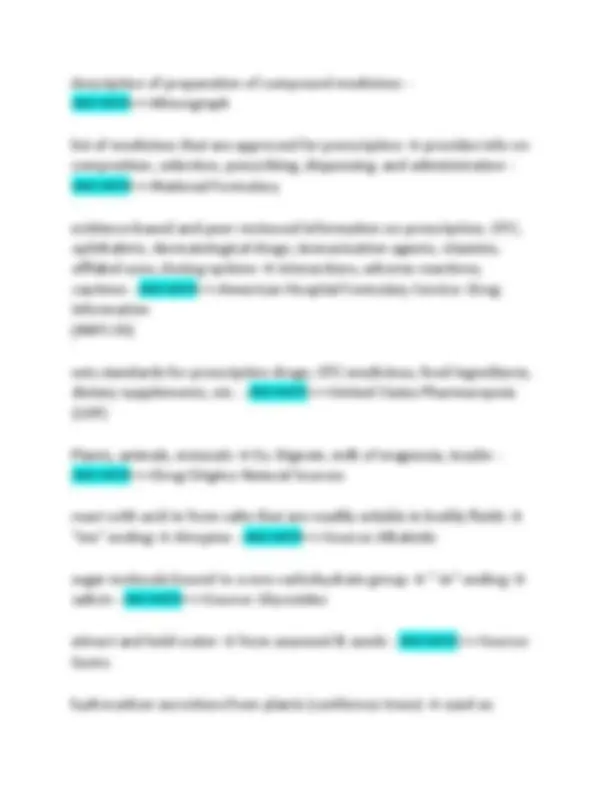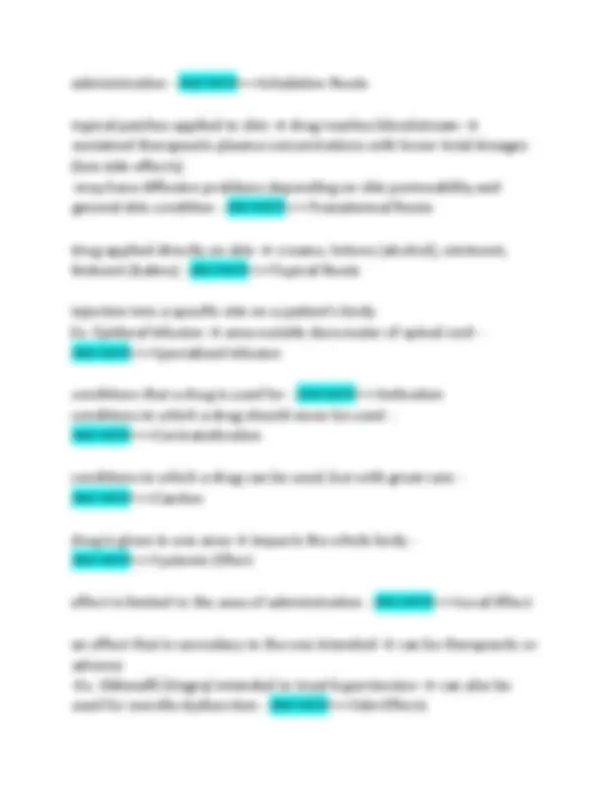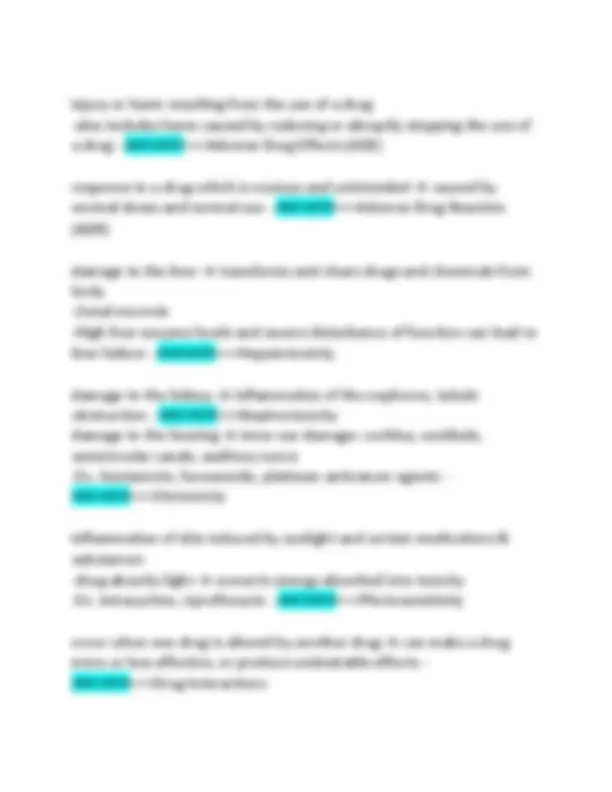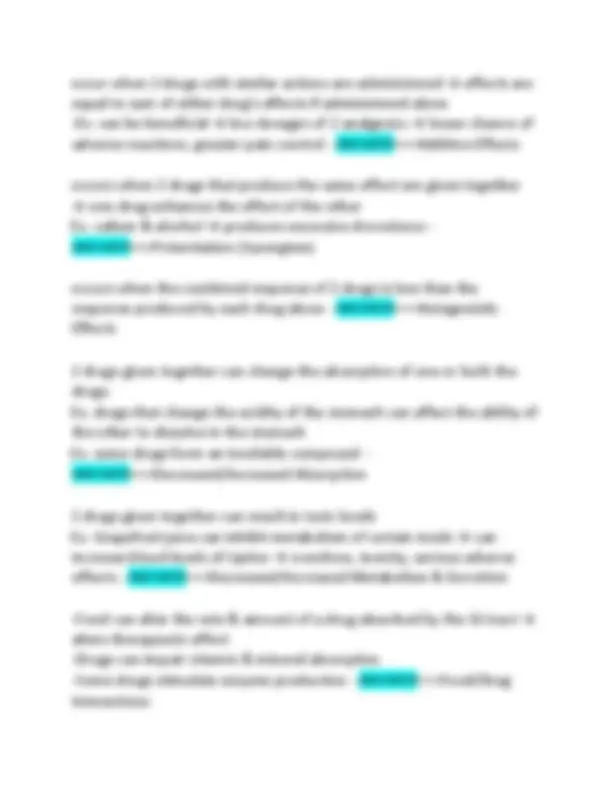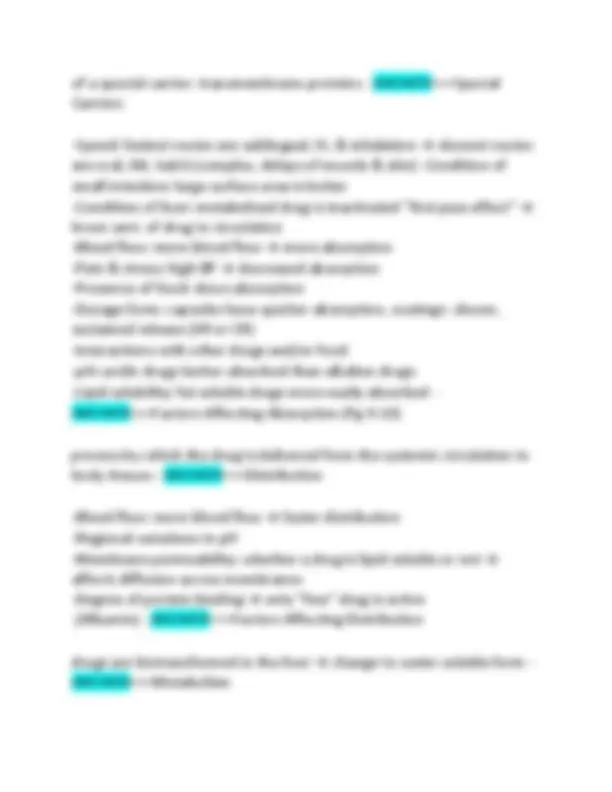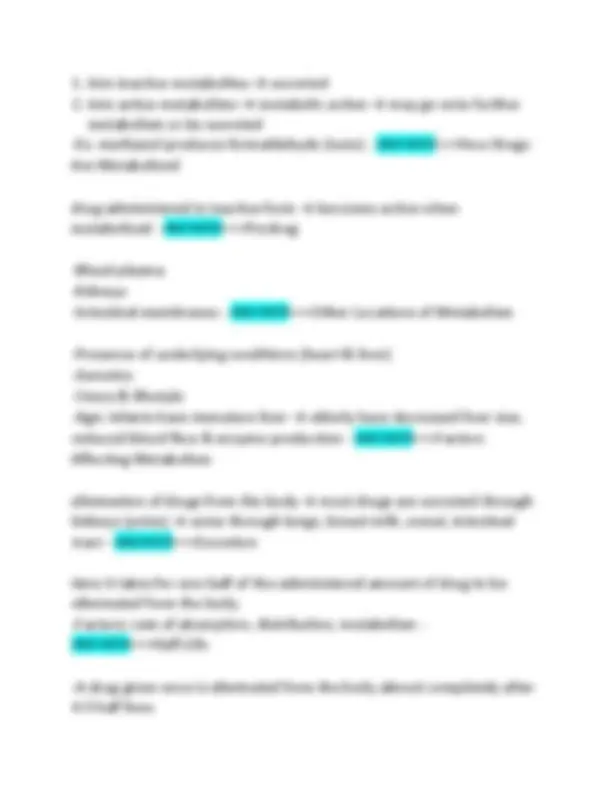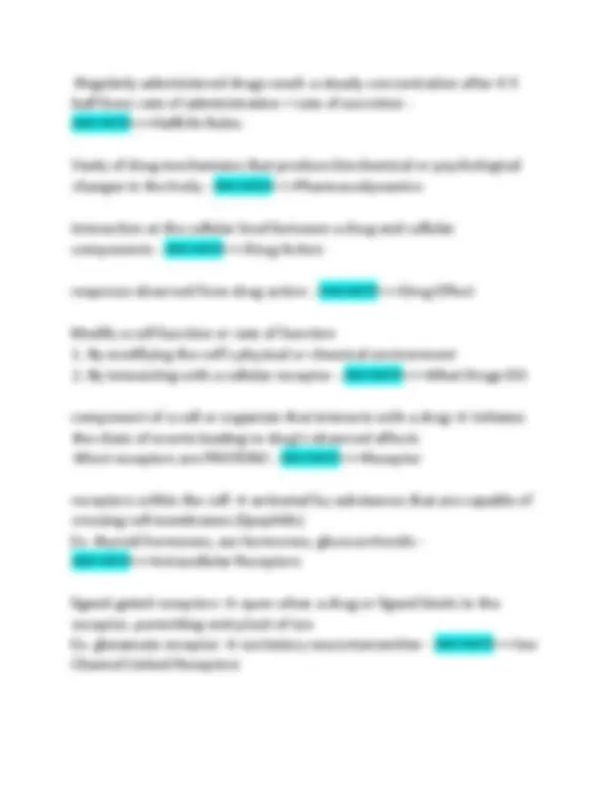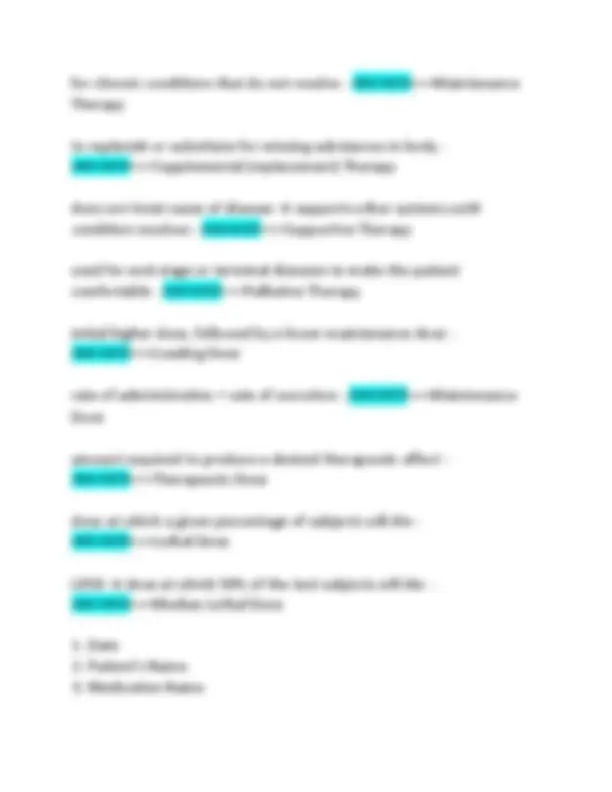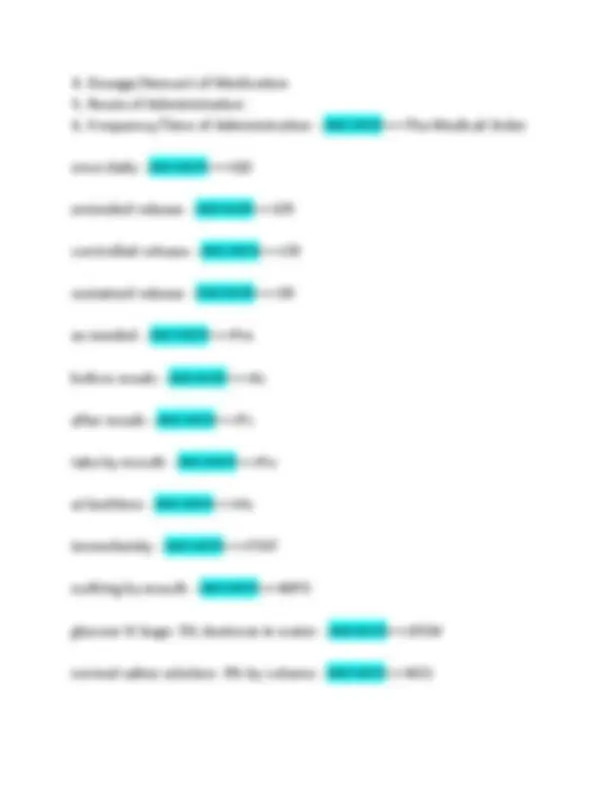Download PSYCHIATRIC MENTAL HEALTH NURSE PRACTITIONER EXAM QUESTIONS WITH COMPLETE SOLUTIONS and more Exams Psychiatry in PDF only on Docsity!
PSYCHIATRIC MENTAL HEALTH NURSE PRACTITIONER EXAM
QUESTIONS WITH COMPLETE SOLUTIONS GUARANTEED PASS
BRAND NEW 2025
the study of substances that interact with living systems through chemical processes - ANSWER>>>Pharmacology any substance that brings about a change in biological function through its chemical actions - ANSWER>>>Drug activator of a specific regulatory molecule (receptor) - ANSWER>>>Agonist inhibitor of a specific regulatory molecule (receptor) - ANSWER>>>Antagonist a substance that may interact with other drugs, removing or preventing that drug from reaching its target - ANSWER>>>Chemical Antagonist a drug that has almost exclusively harmful effects - ANSWER>>>Poison poison of biological origin - ANSWER>>>Toxin Chemical Antagonism- administration of chelating agents to remove heavy metals from the body - ANSWER>>>Chelation Therapy formation and/or presence or 2 or more separate bonds between
polydentate ligand and a single metal center Examples: EDTA, Dimercaptrol - ANSWER>>>Chelation Beneficial: cofactors, present in enzyme, muscle activity Harmful: arsenic (& others) can react with thiol groups on enzymes and deactivate them → toxic effects - ANSWER>>>Metal Ions: Advantages & Disadvantages Chelating agents compete with enzyme thiol groups for binding to metal ion → metal ion binds to chelator instead of enzyme → metalchelator complex is excreted through urine - ANSWER>>>How Chelation Works based on drug's mechanism of action Ex. Beta Blocker- targets beta receptors, interferes with binding of epinephrine & norepinephrine, used for cardiac arrhythmias, hypertension, & CHF - ANSWER>>>Pharmacological Class of Drugs based on clinical effectiveness Ex. Antihypertensives- treat high BP - ANSWER>>>Therapeutic Class of Drugs describes atomic and molecular structure (IUPAC) - ANSWER>>>Chemical Name common name, usually an abbreviation of the chemical name - ANSWER>>>Generic Name brand/propriety name- selected by pharmaceutical company → protected by copyright (patent lasts 17 yrs) Ex. Tylenol, Motrin - ANSWER>>>Trade Name
Examples: Heroin, LSD, Marijuana, Peyote, Ecstasy - ANSWER>>>Schedule 1 Controlled Substances High potential for abuse which may lead to severe psychological or physical dependence Examples: Methadone, Meperidine, Oxycodone, Fentanyl, Methamphetamine - ANSWER>>>Schedule 2 Controlled Substances Potential for abuse less than Schedules 1 or 2 → may lead to moderate or low physical dependence or high psychological dependence Examples: Narcotics, Ketamine, Anabolic Steroids - ANSWER>>>Schedule 3 Controlled Substances Low potential for abuse relative to Schedule 3 Examples: Benzodiazepines, Xanax, Ativan (lorazepam), Valium, Klonopin, Soma - ANSWER>>>Schedule 4 Controlled Substances Low potential for abuse relative to Schedule 4 → consist primarily of preparations containing small amt. of narcotics Examples: cough preparations containing not more than 200 mg of codeine per 100 mL or per 100 g, azogabine - ANSWER>>>Schedule 5 Controlled Substances compilation of manufacturer's prescribing information - ANSWER>>>Physician's Desk Reference (PDR) contains directions for the identification of samples and the preparation of combination medicines → standard created to ensure that all products are of appropriate identity, strength, and purity - ANSWER>>>The United States Pharmacopeia- National Formulary (USPNF)
description of preparation of compound medicines - ANSWER>>>Monograph list of medicines that are approved for prescription → provides info on composition, selection, prescribing, dispensing, and administration - ANSWER>>>National Formulary evidence-based and peer-reviewed information on prescription, OTC, ophthalmic, dermatological drugs, immunization agents, vitamins, offlabel uses, dosing options → interactions, adverse reactions, cautions - ANSWER>>>American Hospital Formulary Service- Drug Information (ANFS-DI) sets standards for prescription drugs, OTC medicines, food ingredients, dietary supplements, etc. - ANSWER>>>United States Pharmacopeia (USP) Plants, animals, minerals → Ex. Digoxin, milk of magnesia, insulin - ANSWER>>>Drug Origins: Natural Sources react with acid to form salts that are readily soluble in bodily fluids → "ine" ending → Atropine - ANSWER>>>Source: Alkaloids sugar molecule bound to a non-carbohydrate group → "-in" ending → salicin - ANSWER>>>Source: Glycosides attract and hold water → from seaweed & seeds - ANSWER>>>Source: Gums hydrocarbon secretions from plants (coniferous trees) → used as
directly into the vein → rapid and predictable absorption, plasma concentration rapidly achieved
- venous access is required → may cause irritation - ANSWER>>>Intravenous (IV) Route infusing an additional medication along with one already being administered- through same IV line - ANSWER>>>IV Piggyback (IVPB) syringe attached to IV line and "pushed" in through line - ANSWER>>>IV Push (Bolus) pump attached to Iv access line → allows for precise control over flow rate and amount of drug - ANSWER>>>IV Infusion gravity flow, regulated by clamp on IV line - ANSWER>>>IV Drip injected into top few layers of skin - ANSWER>>>Intradermal Route under the skin, into the fatty layer (not muscle) → can be used when venipuncture is not possible → prolonged effect
- erratic or slow absorption, painful - ANSWER>>>Subcutaneous (SubQ) Route directly into muscle- can vary in depth → can be used when venipuncture is not possible → prolonged effect
- erratic or slow absorption, painful - ANSWER>>>Intramuscular (IM) Route introduced directly into the respiratory system via gas, vapor, powder through vaporization, gas inhalation, nebulization
- large surface area → rapid absorption
- limited particle size, irritation of alveolar space, complex
administration - ANSWER>>>Inhalation Route topical patches applied to skin → drug reaches bloodstream → sustained therapeutic plasma concentrations with lower total dosages (less side effects)
- may have diffusion problems depending on skin permeability and general skin condition - ANSWER>>>Transdermal Route drug applied directly on skin → creams, lotions (alcohol), ointment, liniment (balms) - ANSWER>>>Topical Route injection into a specific site on a patient's body Ex. Epidural Infusion → area outside dura mater of spinal cord - ANSWER>>>Specialized Infusion conditions that a drug is used for - ANSWER>>>Indication conditions in which a drug should never be used - ANSWER>>>Contraindication conditions in which a drug can be used, but with great care - ANSWER>>>Caution drug is given in one area → impacts the whole body - ANSWER>>>Systemic Effect effect is limited to the area of administration - ANSWER>>>Local Effect an effect that is secondary to the one intended → can be therapeutic or adverse
- Ex. Sildenafil (Viagra) intended to treat hypertension → can also be used for erectile dysfunction - ANSWER>>>Side Effects
occur when 2 drugs with similar actions are administered → effects are equal to sum of either drug's effects if administered alone
- Ex. can be beneficial → low dosages of 2 analgesics → lesser chance of adverse reactions, greater pain control - ANSWER>>>Additive Effects occurs when 2 drugs that produce the same effect are given together → one drug enhances the effect of the other Ex. valium & alcohol → produces excessive drowsiness - ANSWER>>>Potentiation (Synergism) occurs when the combined response of 2 drugs is less than the response produced by each drug alone - ANSWER>>>Antagonistic Effects 2 drugs given together can change the absorption of one or both the drugs Ex. drugs that change the acidity of the stomach can affect the ability of the other to dissolve in the stomach Ex. some drugs form an insoluble compound - ANSWER>>>Decreased/Increased Absorption 2 drugs given together can result in toxic levels Ex. Grapefruit juice can inhibit metabolism of certain meds → can increase blood levels of Lipitor → overdose, toxicity, serious adverse effects - ANSWER>>>Decreased/Increased Metabolism & Excretion
- Food can alter the rate & amount of a drug absorbed by the GI tract → alters therapeutic effect
- Drugs can impair vitamin & mineral absorption
- Some drugs stimulate enzyme production - ANSWER>>>Food/Drug Interactions
Inadvertent adverse effect or complication resulting from medical treatment or advice - ANSWER>>>Latrogenic Issue when a patient's immune system identifies a drug as a dangerous foreign substance → release of vasoactive and inflammatory substances → systemic damage
- patient must have received the drug previously
- must be neutralized or destroyed - ANSWER>>>Drug Allergy decreased response to a drug over time - ANSWER>>>Tolerance responses specific to an individual patient → totally unexpected response → not resulting from pharmacological properties of drug - ANSWER>>>Idiosyncratic Response when large doses are required to elicit a desired effect - ANSWER>>>Hyporeactivity tolerance that develops acutely with only a few doses of a drug - ANSWER>>>Tachyphyraxis damages the fetus - ANSWER>>>Teratogenic Effects acquired need for a drug that may produce psychological or physical symptoms of withdrawal when discontinued - ANSWER>>>Dependence what the body does to the drug → movement of the drug through the body
- ADME: Absorption, Distribution, Metabolism, Excretion - ANSWER>>>Pharmacokinetics
of a special carrier: transmembrane proteins - ANSWER>>>Special Carriers
- Speed: fastest routes are sublingual, IV, & inhalation → slowest routes are oral, IM, SubQ (complex, delays of muscle & skin) - Condition of small intestine: large surface area is better
- Condition of liver: metabolized drug is inactivated "first pass effect" → lower amt. of drug to circulation
- Blood flow: more blood flow → more absorption
- Pain & stress: high BP → decreased absorption
- Presence of food: slows absorption
- Dosage form: capsules have quicker absorption, coatings- slower, sustained release (XR or CR)
- Interactions with other drugs and/or food
- pH: acidic drugs better absorbed than alkaline drugs
- Lipid solubility: fat soluble drugs more easily absorbed - ANSWER>>>Factors Affecting Absorption (Pg 9-10) process by which the drug is delivered from the systemic circulation to body tissues - ANSWER>>>Distribution
- Blood flow: more blood flow → faster distribution
- Regional variations in pH
- Membrane permeability: whether a drug is lipid soluble or not → affects diffusion across membranes
- Degree of protein binding → only "free" drug is active (Albumin) - ANSWER>>>Factors Affecting Distribution drugs are biotransformed in the liver → change to water-soluble form - ANSWER>>>Metabolism
- Into inactive metabolites → excreted
- Into active metabolites → metabolic action → may go onto further metabolism or be excreted
- Ex. methanol produces formaldehyde (toxic) - ANSWER>>>How Drugs Are Metabolized drug administered in inactive form → becomes active when metabolized - ANSWER>>>Prodrug
- Blood plasma
- Kidneys
- Intestinal membranes - ANSWER>>>Other Locations of Metabolism
- Presence of underlying conditions (heart & liver)
- Genetics
- Stress & lifestyle
- Age: infants have immature liver → elderly have decreased liver size, reduced blood flow & enzyme production - ANSWER>>>Factors Affecting Metabolism elimination of drugs from the body → most drugs are excreted through kidneys (urine) → some through lungs, breast milk, sweat, intestinal tract - ANSWER>>>Excretion time it takes for one-half of the administered amount of drug to be eliminated from the body
- Factors: rate of absorption, distribution, metabolism - ANSWER>>>Half-Life
- A drug given once is eliminated from the body almost completely after 4 - 5 half lives
activated by the activation of 7 transmembrane units → G-proteins activate ion channels or other enzymes → cascade effect
- "molecular switches"- involved in transmitting signals from outside the cell to inside the cell - ANSWER>>>G-Protein Receptors enzyme activity activated by activation of 1 transmembrane unit - binding and activation of protein kinases - ANSWER>>>Enzyme Linked Receptors attracted to receptor (affinity) → binds to receptor & causes a response → institutes a conformational change → initiates series of events → produces pharmacological response - ANSWER>>>Action of Agonist Drugs the transduction process linking the occupancy of the receptor and the pharmacological response - ANSWER>>>Coupling the ability of a drug to initiate a response after binding to a receptor - ANSWER>>>Intrinsic Activity when a drug has an affinity for a receptor, but displays little or no intrinsic activity → binds to receptors but not to activate them - role: prevent agonists from activating receptors, prevents response
- types: competitive & non-competitive - ANSWER>>>Antagonist Drugs competes with the agonist for the receptor site → reversibly binds to the receptor site
- if concentration of antagonist > agonist → response is prevented completely
- if concentration of agonist > antagonist → agonist can surmount effects of antagonist - ANSWER>>>Competitive Antagonist Drugs
binds to the receptor site → blocks effects of agonist
- can be "tight" association or actual covalent bond (irreversible binding) → receptor becomes unavailable for binding to the agonist - ANSWER>>>Non-Competitive Antagonist Drugs relative amount of a drug required to produce a desired response (strength)
- low dose → low response
- as dose increases → response increases
- maximum effectiveness → response will plateau - ANSWER>>>Drug Potency relationship between a drug's desirable therapeutic effects and it's adverse effects → measures the difference between an effective dose for 50% of patients treated (ED50) and the minimal dose where adverse reactions occur (TD50) - ANSWER>>>Margin of Safety/Therapeutic Index TD50/ED
- Low TI: narrow range of safety between effective dose and lethal dose → high risk of toxic effects - ANSWER>>>Therapeutic Index Calculation the use of drugs to treat disease - ANSWER>>>Pharmacotherapeutics critically ill patient, requires acute intensive therapy - ANSWER>>>Acute Therapy based on practical experience instead of scientific data - ANSWER>>>Empiric Therapy
- Dosage/Amount of Medication
- Route of Administration
- Frequency/Time of Administration - ANSWER>>>The Medical Order once daily - ANSWER>>>QD extended release - ANSWER>>>ER controlled release - ANSWER>>>CR sustained release - ANSWER>>>SR as needed - ANSWER>>>Prn before meals - ANSWER>>>Ac after meals - ANSWER>>>Pc take by mouth - ANSWER>>>Po at bedtime - ANSWER>>>Hs immediately - ANSWER>>>STAT nothing by mouth - ANSWER>>>NPO glucose IV bags- 5% dextrose in water - ANSWER>>>D5W normal saline solution- 9% by volume - ANSWER>>>NSS
no known allergies - ANSWER>>>NKA

